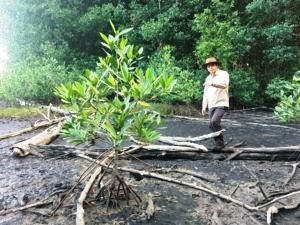Sometimes, progress means helping nature do what it does best. This seems to be the case for a once-barren 200-acre piece of land surrounded by lush mangrove forests in El Salvador.
Mangrove forests provide an vast array of valuable ecosystem services and play a critical role in climate change mitigation and adaptation; they sequester carbon, slow coastal erosion, and form a natural barrier that protects coastal communities from extreme weather. Mangrove ecosystems are a refuge for juvenile fish, a nesting habitat for birds, and a breeding ground for sea turtles. They also provide sustainable economic opportunities for local communities who fish, extract timber, and develop ecotourism initiatives.
The most extensive remaining mangrove forest in Central America is located in the Bay of Jiquilisco in the Lower Lempa region of El Salvador. At 632 square kilometers, the Bay of Jiquilisco is El Salvador’s largest wetlands complex and protected area, designated as both a Ramsar Wetland of International Importance and a UNESCO Biosphere Reserve.
Unfortunately, El Salvador has lost 60% of its mangrove coverage since 1950 and continues to lose mangroves at a rate of 681 hectares (just under 7 square kilometers) each year (MARN 2014). Climate change, deforestation, pollution, large-scale agricultural development, and over-exploitation of natural resources continue to threaten this critical resource. This loss threatens the livelihoods and safety of the communities and wildlife that depend on the health of this ecosystem for their survival.

EcoViva Program Director José María Argueta points out new mangrove growth at the El Llorón site. Photo: Ana Luisa Ahern.
However, a ray of hope shines down on a pocket of formerly degraded mangrove forest in the Bay of Jiquilisco. A group of concerned citizens, with the support of national and international partners, decided to turn the tide on mangrove deforestation and attempt to return a sad swath of destroyed forest to its former natural glory.
In 2011, EcoViva and its partner the Mangrove Association, along with technical experts from Mangrove Action Project, introduced ecological mangrove restoration (EMR) to El Salvador and tested it on a patch of land called El Llorón.
This technique, defined by the Mangrove Action Project as “an approach to coastal wetland restoration that seeks to facilitate natural regeneration in order to produce self-sustaining wetland ecosystems,” emphasizes restoring the natural functioning of the ecosystem to allow it to grow back on its own rather than rely on traditional seed-planting, which has had little efficacy in the past.
Environmental restoration is a long process; results can take years, sometimes decades, to fully materialize. Mangrove restoration is no different. More than six years have passed since the communities of the Bajo Lempa came together to clear debris and sediment, dig canals, and allow the tides to do the work of bringing this patch of damaged earth back to life. Six years is a relatively short amount of time in the grand scheme of things, but we are starting to notice signs that in that time, nature has been hard at work.
New mangrove seedlings can be seen sprouting from the ground. Birds can be heard cackling in the canopy. Delicate animal tracks dot the muddy landscape. And from the satellites above, we can see new green growth taking root along the edges of the once-barren patch of brown. The communal effort is starting to bear fruit, and we will continue to study, protect, and nurture this sprig of hope as nature takes its course.
Featured photos via Google Maps.
This article originally appeared on the EcoViva website.

